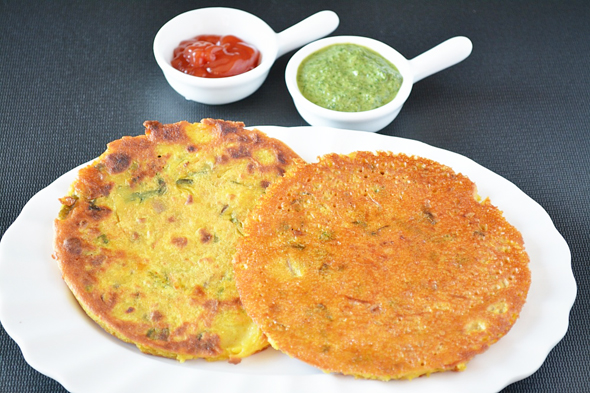Mama’s Punjabi Recipes: Besan De Poode (Chickpea Flour Flatcakes)
Saved under Community, Current Stories, Recipe Corner
Tags: Baytown, Besan De Poode, Clear Lake, Cypress, Desi news, Greater Houston, Houston, Houston Desi news, India, Indian American community, Indian News, Indians in America, Indo-American News, Katy, Mama’s Punjabi Recipes, NRI, pearland, south asia, South India, Sugar Land, Texas, USA
By popular demand from many readers, below is a reprint of Mama’s Besan de Poode recipe, which is a tasty, inexpensive, fast comfort food for rainy days and for uninvited guests. It is reprinted with some additional information and directions.
Judging from the many different types of snacks it is used in, besan (chickpea flour) can easily be considered a very versatile ingredient in many Indian dishes. Whether it is in seviyan (crispy noodles), pakoras (fried fritters), laddus (sweetballs) or kaddi (a smooth curry); besan is used so widely that often people forget that it is part of what they are eating. You can even make boondi (besan fried drops) to put in dahi (yogurt) or simply besan ki barfi (sweetened flat cake) or poode (flatcakes).
Besan (roasted gram flour or garbanzo flour or chickpea flour) is high in carbohydrates and somewhat high in protein but has no gluten, which makes it not suitable for those trying to lose weight (especially when it is fried). Besan is also high in protein, magnesium (47%), phosphorus (45%) and potassium (18%). In our home remedies, besan pooda are given to people to help reduce their sugar levels. It is also used to lighten skin, reduce oiliness and fight pimples and to get long, healthy hair.
Poode are made of a paste of besan mixed with spices, then poured onto a tava or flatplate and cooked into a 6-inch round, ¼ inch thick pancake. Once cooked, these poode are eaten with chutney or achaar or even with ketchup by young people! Just like pakoras (fried fritters), poode taste great on a rainy day, with warm tea.
Poode are also called “chilla” by people from Uttar Pradesh. They are also a quick dish and it resembles a flour pancake, except it is salty and spicy. Poode can be a snack, but a really filling one as you can’t resist eating only one!
Ingredients:
• 1 cup besan (chickpea flour) – makes four 6-inch round poode
• ½ cup dahi (plain yogurt)
• 1 medium pyaaz (onion)
• ½ cup pani (water)
• 1 teaspoon of vegetable or olive oil for each pooda
• Spices (to taste): namak (salt), mirch (red pepper). If desired, add ajwain (carom seeds) for a slightly bitter taste.
Directions:
1. Peel and chop the onions and set aside.
2. Mix the besan (chickpea flour), yogurt and water together, mixing continuously so that lumps do not form and
3. Add the onions and spices and beat the mixture till it becomes a paste: it should not be too thin else the pooda will not cook and will remain wet inside.
4. Before making the first pooda, pre-heat the tava (flatplate) or frying pan on a high flame and coat it with a half teaspoon of oil. When it is hot, turn the heat down to medium.
5. Pour a small amount of mixture with a large spoon and and spread it to make a 6-inch circle.
6. When tiny holes appear on the surface, check to see in the bottom side is golden brown; if so, the gently flip the pooda over with a spatula. Sprinkle a little oil around the edges and let it cook till it is slightly brown on both sides.
7. Cook the other side and make sure the pooda is not mushy and moist, but do not let it cook too long or become too brown.
8. Place the pooda on a plate and repeat till all the mixture is done. If you do not use all the mixture, just cover it and keep in the refrigerator for use another day.
9. Serve with mint chutney or ketchup or achaar (pickles) of your choice.
MAMA’S TIP OF THE WEEK
While cooking, use whole saunf (fennel seeds), but not its powder
Dried saunf (fennel seeds) are often used as a digestive and mouth freshener after a meal, but the seed, especially the thinner, smaller and sweeter variety, is a better choice than the coarser, thicker seeds. In foods and beverages, fennel oil is used as a flavoring agent and as a fragrance ingredient in soaps and cosmetics.
Fennel seeds are often used in cooking Indian sweet dishes but only the seeds when mixed in the dough of some puddings or rice dishes. But when sprinkled over a dish and cooked, the saunf powder turns a dark brown and leaves the dish looking less than appetizing.

Shakuntla Malhotra is a skilled cook of Punjabi dishes made in the old-fashioned style that she learnt as a young woman in her ancestral home in Lyallpur (since renamed Faisalabad), India before it became part of Pakistan after the Partition in 1947. People have often admired her cooking for its simplicity and taste that comes with each mouthful. Even in her mid-eighties, she continues to cook daily and agreed to share some of her delectable Punjabi recipes

